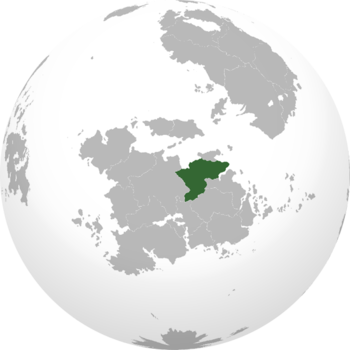Veltorina
This article is a work-in-progress because it is incomplete and pending further input from an author. Note: The contents of this article are not considered canonical and may be inaccurate. Please comment on this article's talk page to share your input, comments and questions. |
Veltorine People's Republic Populi Republicae Veltorinum | |||||||||||
|---|---|---|---|---|---|---|---|---|---|---|---|
| 1782–1953 | |||||||||||
|
Flag | |||||||||||
 | |||||||||||
| Capital | Constantinopolis Borealis | ||||||||||
| Capital-in-exile | New Malavia (1953-2034) | ||||||||||
| Common languages | Latin, Istroyan | ||||||||||
| Religion | Levantine Catholicism | ||||||||||
| Demonym(s) | Veltorine | ||||||||||
| Government | Single party parliamentary state | ||||||||||
| State Basileus | |||||||||||
• 1933-1953 | Tiberius Heraklonas | ||||||||||
| History | |||||||||||
• End of Veltorine War of Independence | 1782 | ||||||||||
• End of Great War | 1953 | ||||||||||
| Population | |||||||||||
• 1950 | 195,747,329 | ||||||||||
| |||||||||||
| |||||||||||
The Veltorine People's Republic was a country in northeastern Sarpedon from the end of the 18th through the middle of the 20th centuries.
Beginning in the medieval period, the eastern provinces were sites of constant political, social, and religious upheaval. Unlike other parts of the country, much of Veltorina retained a fierce devotion to the Catholic Church after the adoption of Imperial Catholicism, creating a vast religious divide between the eastern and western parts of the nation. The Catholic Church, though underground, retained a great deal of influence over eastern society. Those residing in the eastern provinces, additionally, were far more likely to have some partial degree of Istroyan descent rather than the Latinic majority of western Caphiria. The social and religious divide was compounded by the distance of the provinces from Venceia, which, in the pre-modern era, struggled with supply and reinforcement issues. As a result of all of this, Veltorina developed a national identity related to, but independent of, the Caphirian people.
Gaining independence from Caphiria after the long Veltorine War of Independence from 1769-1782. Established by the landed class of former eastern Caphiria, the nation was a largely rural and agricultural country for the first half of the 19th century, and contemporaries noted the excessive level of social stratification between the class of planters and serfs. The Tyrian Revolution in 1864 seized control of the Republic, becoming the first socialist state of its kind in the Occidental world. Following a period of rapid industrialization, which alarmed both Caphiria and Urcea, the revolution came to a functional end and the state became stable with the creation of the office of State Basileus in 1892. A relatively modern and industrialized country, Veltorina was a great power prior to the Great War. Invaded by Caphiria during the conflict, it became a primary front of the conflict and saw heavy involvement of the Armed Forces of the Apostolic Kingdom of Urcea before it was ultimately annexed by Caphiria at the end of the war. Following its annexation, it became the modern provinces of Thessia, Leonia, Amarsia, and Sennium, the so-called "Four New Provinces". The Veltorine government-in-exile continues to exist, and from 1953-2034 it enjoyed residency in Dorhaven, where it attracted large hosts of Veltorine emigres.
Etymology
Geography
History
Government
Culture
Like Caphiria, Veltorine society was highly stratified. Although the institutional significance of ordo was less pronounced in Veltorina and traditional distinctions in social rank began to blur not long after independence, there nonetheless remained a clear hierarchy between the latifundial aristocracy and the peasant majority. A large percentage of the latter were serfs until the abolition of serfdom in 1843, and a smaller percentage were held as slaves until 1897 - a source of constant scandal for a self-avowed "socialist" state.